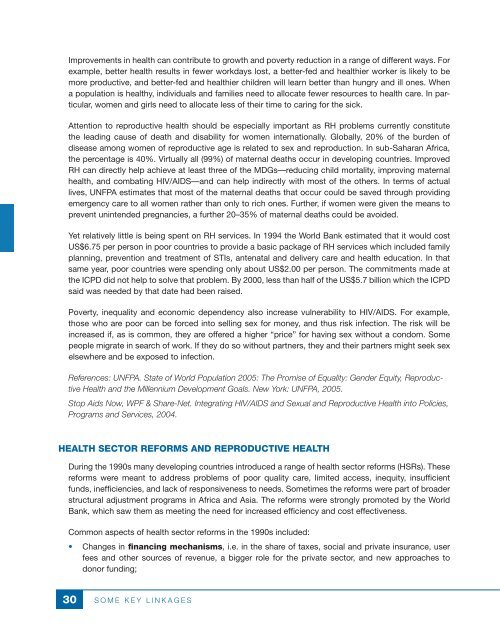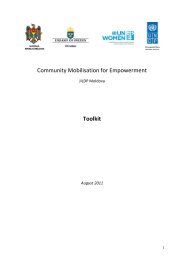Gender Responsive Budgeting and Women's Reproductive Rights ...
Gender Responsive Budgeting and Women's Reproductive Rights ...
Gender Responsive Budgeting and Women's Reproductive Rights ...
You also want an ePaper? Increase the reach of your titles
YUMPU automatically turns print PDFs into web optimized ePapers that Google loves.
Improvements in health can contribute to growth <strong>and</strong> poverty reduction in a range of different ways. Forexample, better health results in fewer workdays lost, a better-fed <strong>and</strong> healthier worker is likely to bemore productive, <strong>and</strong> better-fed <strong>and</strong> healthier children will learn better than hungry <strong>and</strong> ill ones. Whena population is healthy, individuals <strong>and</strong> families need to allocate fewer resources to health care. In particular,women <strong>and</strong> girls need to allocate less of their time to caring for the sick.Attention to reproductive health should be especially important as RH problems currently constitutethe leading cause of death <strong>and</strong> disability for women internationally. Globally, 20% of the burden ofdisease among women of reproductive age is related to sex <strong>and</strong> reproduction. In sub-Saharan Africa,the percentage is 40%. Virtually all (99%) of maternal deaths occur in developing countries. ImprovedRH can directly help achieve at least three of the MDGs—reducing child mortality, improving maternalhealth, <strong>and</strong> combating HIV/AIDS—<strong>and</strong> can help indirectly with most of the others. In terms of actuallives, UNFPA estimates that most of the maternal deaths that occur could be saved through providingemergency care to all women rather than only to rich ones. Further, if women were given the means toprevent unintended pregnancies, a further 20–35% of maternal deaths could be avoided.Yet relatively little is being spent on RH services. In 1994 the World Bank estimated that it would costUS$6.75 per person in poor countries to provide a basic package of RH services which included familyplanning, prevention <strong>and</strong> treatment of STIs, antenatal <strong>and</strong> delivery care <strong>and</strong> health education. In thatsame year, poor countries were spending only about US$2.00 per person. The commitments made atthe ICPD did not help to solve that problem. By 2000, less than half of the US$5.7 billion which the ICPDsaid was needed by that date had been raised.Poverty, inequality <strong>and</strong> economic dependency also increase vulnerability to HIV/AIDS. For example,those who are poor can be forced into selling sex for money, <strong>and</strong> thus risk infection. The risk will beincreased if, as is common, they are offered a higher “price” for having sex without a condom. Somepeople migrate in search of work. If they do so without partners, they <strong>and</strong> their partners might seek sexelsewhere <strong>and</strong> be exposed to infection.References: UNFPA. State of World Population 2005: The Promise of Equality: <strong>Gender</strong> Equity, <strong>Reproductive</strong>Health <strong>and</strong> the Millennium Development Goals. New York: UNFPA, 2005.Stop Aids Now, WPF & Share-Net. Integrating HIV/AIDS <strong>and</strong> Sexual <strong>and</strong> <strong>Reproductive</strong> Health into Policies,Programs <strong>and</strong> Services, 2004.Health sector reforms <strong>and</strong> reproductive healthDuring the 1990s many developing countries introduced a range of health sector reforms (HSRs). Thesereforms were meant to address problems of poor quality care, limited access, inequity, insufficientfunds, inefficiencies, <strong>and</strong> lack of responsiveness to needs. Sometimes the reforms were part of broaderstructural adjustment programs in Africa <strong>and</strong> Asia. The reforms were strongly promoted by the WorldBank, which saw them as meeting the need for increased efficiency <strong>and</strong> cost effectiveness.Common aspects of health sector reforms in the 1990s included:• Changes in financing mechanisms, i.e. in the share of taxes, social <strong>and</strong> private insurance, userfees <strong>and</strong> other sources of revenue, a bigger role for the private sector, <strong>and</strong> new approaches to .donor funding;30S O M E K E Y L I N K A G E S





